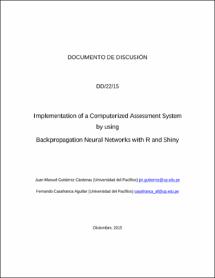| dc.contributor.author | Gutiérrez Cárdenas, Juan M. | |
| dc.contributor.author | Casafranca Aguilar, Fernando | |
| dc.date.accessioned | 2016-06-10T21:36:11Z | |
| dc.date.available | 2016-06-10T21:36:11Z | |
| dc.date.issued | 2015-12 | |
| dc.identifier.uri | http://hdl.handle.net/11354/1087 | |
| dc.identifier.citation | Gutiérrez, J., & Casafranca, F. (2015). Implementation of a computerized assessment system by using backpropagation neural networks with R and shiny. Lima: Universidad del Pacífico, Centro de Investigación. Recuperado de http://hdl.handle.net/11354/1087 | es_PE |
| dc.description.abstract | Las dificultades a las que los estudiantes se enfrentan y su lucha por dominar los temas, podría aumentar como consecuencia de la inadecuada utilización de materiales de evaluación. Generalmente se encuentran en el aula alumnos que hacen buen uso del material de los cursos y de una manera rápida, mientras que otros presentan dificultades con el aprendizaje del material. Esta situación es fácilmente visto en los resultados de los exámenes, un grupo de estudiantes podrían obtener buenas calificaciones animándoles, mientras que otros obtendrían la mala percepción de que los temas son difíciles, y en algunos casos, obligándolos a abandonar el curso o en otros casos a cambiar de carrera. Creemos que mediante el uso de técnicas de aprendizaje automático, y en nuestro caso la utilización de redes neuronales, sería factible crear un entorno de evaluación que podrían ajustarse a las necesidades de cada estudiante. Esto último disminuiría la sensación de insatisfacción de los alumnos y el abandono de los cursos. | es_PE |
| dc.description.abstract | The discouragement, that early undergraduate students suffer when they are faced to topics that they struggle to master, could increase owing by the use of inadequate evaluation materials. It is generally found that in the classroom there are students that manage to cope with the material of the courses in a quick manner, while others present difficulties while learning the material. This situation is easily spotted in the examination results, a group of students could get good marks encouraging them to tackle the course optimistically while others would get the wrong perception that the topics are difficulty, and in some cases, forcing them to leave the course or in other cases to change careers. We believe that by the use of machine learning techniques, and in our case the utilization of neural networks, it would be feasible to make an evaluation environment that could adjust to the needs of each student. The latter means that the system could auto tune the difficulty of the given questions to the students, allowing a more dynamic evaluation system which at the end would decrease the feeling of dissatisfaction and drop off the courses. | en |
| dc.format | application/pdf | es_PE |
| dc.language.iso | eng | es_PE |
| dc.publisher | Universidad del Pacífico. Centro de Investigación | es_PE |
| dc.relation.ispartofseries | Documento de discusión;n° DD/15/22 | |
| dc.rights | info:eu-repo/semantics/openAccess | es_PE |
| dc.rights | Atribución-NoComercial-SinDerivadas 4.0 Internacional | * |
| dc.rights.uri | http://creativecommons.org/licenses/by-nc-nd/4.0/deed.es | * |
| dc.source | Repositorio de la Universidad del Pacífico - UP | es_PE |
| dc.source | Universidad del Pacífico | es_PE |
| dc.subject | Enseñanza universitaria | es_PE |
| dc.subject | Métodos de enseñanza | es_PE |
| dc.subject | Redes neuronales (Computadoras) | es_PE |
| dc.title | Implementation of a computerized assessment system by using backpropagation neural networks with R and shiny | es_PE |
| dc.type | info:eu-repo/semantics/workingPaper | es_PE |
| dc.publisher.country | Perú | es_PE |


